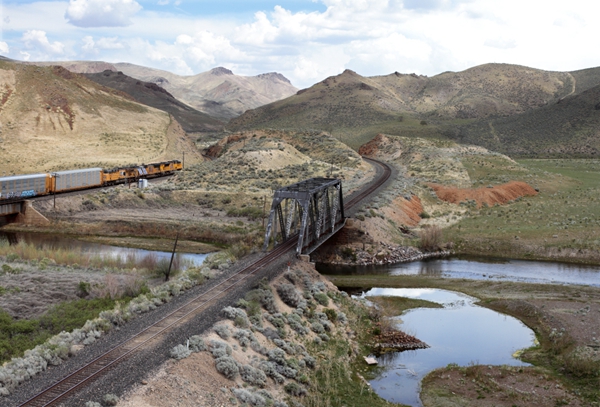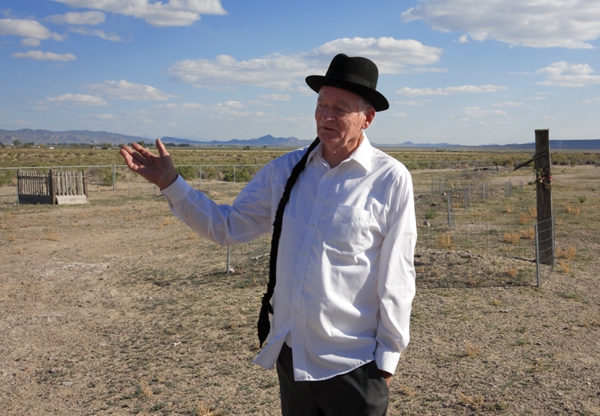Parallel photos commemorate Chinese railroad workers in the US
- By Daniel Xu
 0 Comment(s)
0 Comment(s) Print
Print E-mail China.org.cn, October 2, 2017
E-mail China.org.cn, October 2, 2017
|
|
|
Left: Chinese and Irish laborers lay tracks near Humboldt River in northern Nevada in the summer of 1868. (Photo by Alfred Hart, courtesy of Li Ju) Right: Same location in July 2017. (Photo by Li Ju) |
In 2010, Li Ju was looking for a trail to cross North America during a trip to the U.S., not knowing one was blazed by his Chinese ancestors almost 150 years ago.
Following their footsteps, the freelance photographer captured scenes along the railroad built by Chinese laborers as well as memories from that silent generation that helped to jumpstart the U.S.’s rise as a global superpower.
Along the trail
“If the Chinese could build the Great Wall of China, they should be quite useful in building a railroad.”
So begins an article titled “‘Quiet Movers of Mountains” from the May 8, 1969, issue of the Sacramento Union. The newspaper was one of many artifacts Li collected on his journey along the First Transcontinental Railroad.
|
|
|
Photographer Li Ju carries his camera and equipment as he searches the Sierra Nevada mountains for the locations captured by Alfred Hart. (Photo courtesy of Li Ju) |
To trace the 1,110 kilometer length of the railroad from Sacramento, California, to Promontory, Utah, Li took six separate trips between 2012 and 2017. His main project was to photograph the same locations along the railroad as the ones that appear in a collection of historical photographs by Alfred Hart, taken in the 1860s.
The two sets of historical and modern photos, along with various artifacts and documents, are currently on display at the Overseas Chinese History Museum of China in Beijing. The exhibition will last until Oct. 8.
To find the exact locations where Hart may once have stood and match the angles and framing of his photos, Li drove miles off road and climbed rocky inclines. In doing so, he got a taste firsthand of the tough conditions the Chinese workers labored in.
“I climbed to this spot three times for this photo, because the first two times there was too much snow, and you couldn’t tell it is the same location as in Hart’s photo,” Li said, pointing to a photo overlooking two tunnel entrances in the rocky Sierra Nevada mountains.
|
|
|
Left: Tunnels No. 6 and No. 7 being drilled in the snowy Sierra Nevada mountains in the fall of 1866. (Photo by Alfred Hart, courtesy of Li Ju) Right: Same location, taken from atop Tunnel No. 8 on May 2, 2015. (Photo by Li Ju) |
For another photo, deep within an unlit tunnel, Li carefully examined the surfaces of the interior walls with a flashlight while holding up Hart’s photo to compare the rocky edges and features.
|
|
|
Left: Summit tunnel in the Sierra Nevada mountains. (Photo by Alfred Hart, courtesy of Li Ju) Right: Same location, May 24, 2015. (Photo by Li Ju) |
Huang Annian, professor of the School of History at Beijing Normal University, said Li’s work offers great value to the academic community and is on the same level as research work done by professional historians in the U.S. and China.
“The images would not be possible without [Li’s] dedication and hard work,” Huang said. “These photos tell the important story of the Chinese railroad workers 150 years ago who raised a historical monument for the relationship between China and the U.S.”
The silent generation
One of the most well-known photos of the First Transcontinental Railroad was from its May 1969 completion ceremony. The Central Pacific Railroad section, coming from the west, met in Promontory with the Union Pacific Railroad section, coming from the east. Curiously, one can hardly spot any Chinese workers in the photo.
|
|
|
At the ceremony for the driving of the “last spike” at Promontory Summit, Utah, on May 10, 1969. (Photo courtesy of Li Ju) |
Contrary to the common assumption that they were intentionally left out, Li believed it probably had more to do with the workers’ own superstitions. “They were afraid that photography could steal their souls.” Li said that according to Central Pacific’s records, eight Chinese workers who laid the railroad’s final track were honored at the post-ceremony feast.
The railroad company did not always respect the Chinese workers, who were seen as too physically weak for hard labor due to their small stature. However, when Central Pacific began to lose more and more white laborers as it faced the increasingly daunting task of laying tracks through mountain terrains, the company was forced to try out 50 Chinese workers.
The company heads were surprised. In a statement made by Central Pacific president Leland Stanford to the U.S. government, he said Chinese laborers were “quiet, peaceable, patient, industrious and economical—ready and apt to learn all the different kinds of work required in railroad building, they soon [became] as efficient as white laborers.”
To compete against the Union Pacific Railroad company for a larger part of the government contract, Central Pacific began recruiting droves of Chinese workers in 1865. During the four years until the railroad’s completion, the company at one time employed as many as 12,000 Chinese laborers.
They mostly came from Southern China around today’s Guangdong and Fujian provinces, a region with a long tradition of emigrant workers to overseas areas. Some went to America to escape poverty and unrest, but most just wanted to make good wages to bring home to their families in China, Huang said.
Still, their pay was lower than their white counterparts’, and eventually they comprised as much as 90 percent of Central Pacific’s labor force. Using simple tools and methods, the Chinese laborers blasted through 15 tunnels and laid tracks over terrains that rose over 2,000 meters. Many perished in the harsh winters and dangerous conditions, and more died from a smallpox outbreak in the work camps. The exact death count was lost to a fire that destroyed Central Pacific’s records.
Through it all, the Chinese laborers endured, and the First Transcontinental Railroad was completed seven years ahead of schedule.
|
|
|
A Chinese laborer works outside Tunnel No. 8. (Photo by Alfred Hart, courtesy of Li Ju) |
Huang said it was regrettable that unlike in other notable events linking China and the U.S. since establishing formal trade 1784, the Chinese railroad workers did not have among them a well-known historical figure. Thus, the importance they played in the relationship between the two countries was left out of the history books.
Even worse, following the financial crisis in 1873, Chinese laborers were blamed for depressed wages, eventually resulting in the infamous 1882 Chinese Exclusion Act. Those who once helped to build up America became black marks in the country’s history of racial discrimination, their achievement overshadowed and forgotten.
“They were the silent generation,” Huang said.
Paving the way for the future
In recounting the significance of the First Continental Railroad, Huang said it expedited the westward migration and settlement of Americans while integrating the U.S. economy and industry from coast to coast. It also allowed the country to stabilize and secure its western territories after acquiring California from Mexico and ending the Civil War.
“The completion of this railroad was one of the major events that marked the beginning of America’s rise as a superpower,” Huang said.
Today, while small sections have been rerouted and the tunnels reinforced, the main railroad continues to operate as built, serving as the backbone of the country’s overland freight industry.
|
|
|
The First Transcontinental Railroad, now part of the Union Pacific Railroad, continues to serve as the backbone of America’s overland freight industry today. (Photo by Li Ju) |
“One of the biggest surprises during my trips was how friendly local Americans were toward us,” Li said. Much of the land the railroad runs through is private, but when residents and even railroad security saw Li’s camera and learned about his project, they gave Li access and even pointed him to places he might have missed.
Many of the century-old train stations in towns along the railroad have been turned into small museums, and they were usually Li’s first stops. Li learned about the Chinese cemetery at one such museum in the town of Lovelock, Nevada.
The cemetery was being cared for by Larry DeLeeuw, the owner of a local motel, who raised fences and built a gate for the cemetery after learning about the railroad’s history. Li said he was especially moved when he found that DeLeeuw bought ads in the regional newspapers inviting local Chinese Americans to come and pay respect every year on Qingming, China’s traditional tomb-sweeping festival.
|
|
|
In Lovelock, Nevada, motel owner Larry DeLeeuw serves as caretaker of the local Chinese cemetery to honor the history of the Chinese railroad workers. (Photo by Li Ju) |
Li said he hoped more Americans would learn about contributions by Chinese laborers to the U.S., as it would not only elevate the status of Chinese Americans in the country, but also improve U.S.-China relations.
Huang agreed. He said the First Transcontinental Railroad was an example of a successful collaboration between China and the U.S. in infrastructure construction.
“If Chinese laborers could build that railroad under those harsh conditions a century and a half ago, why can’t [similar things] happen today?”














Go to Forum >>0 Comment(s)